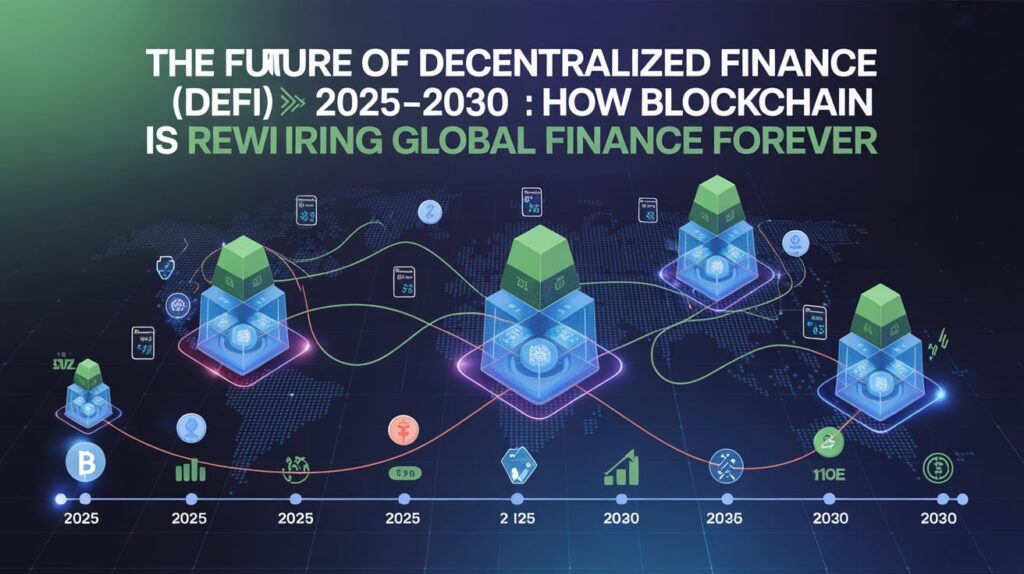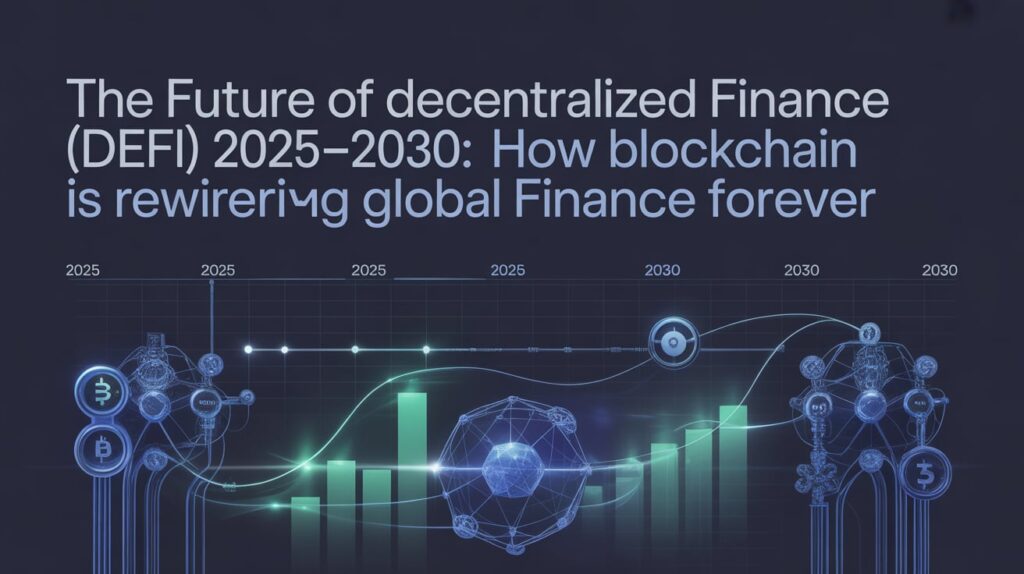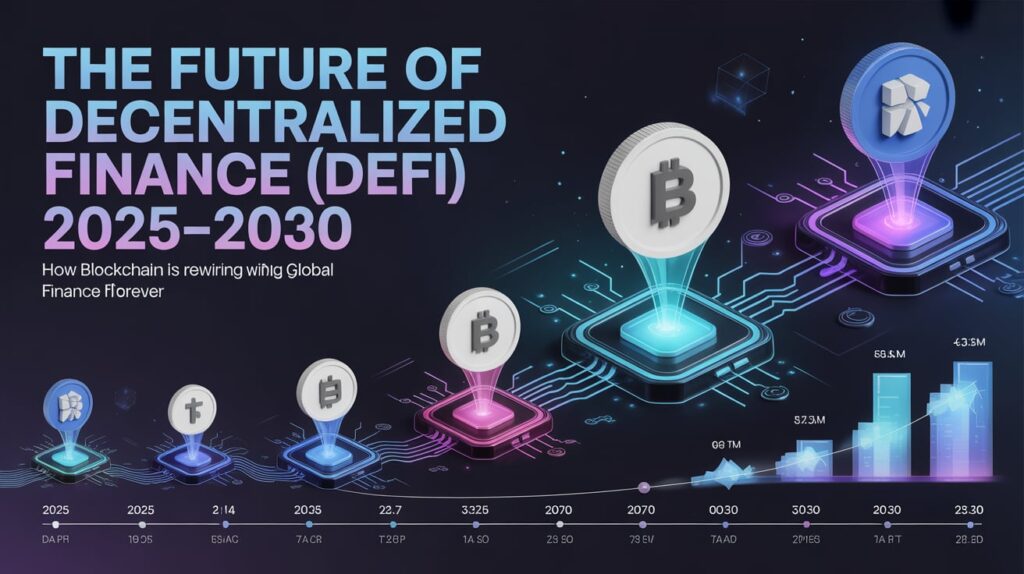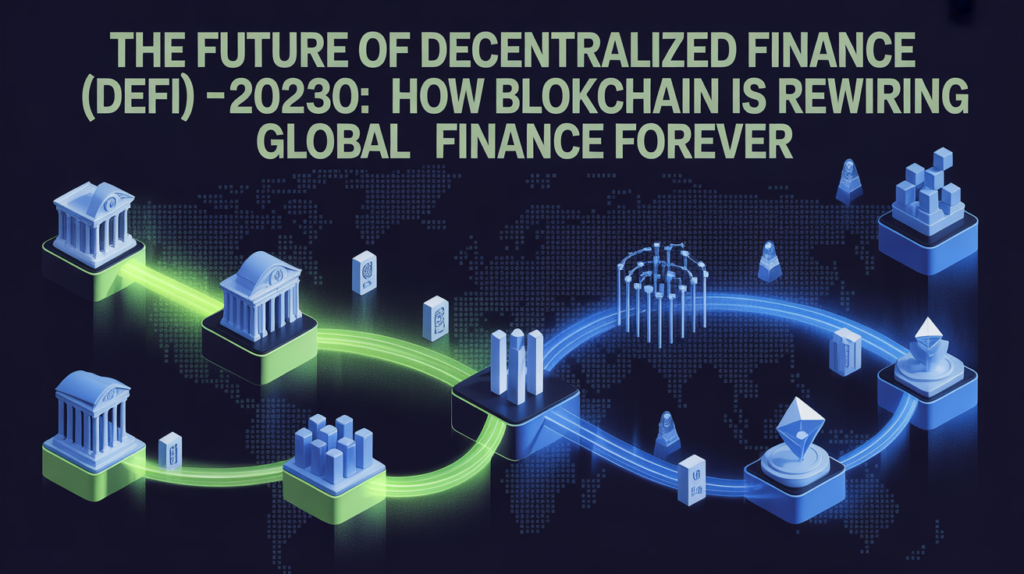The Future of Decentralized Finance (DeFi) 2025–2030: How Blockchain Is Rewiring Global Finance Forever

The financial world is changing faster than ever before. What began with Bitcoin as “digital money” has evolved into an entire financial ecosystem that operates without banks, borders, or bureaucracy. Welcome to the future of decentralized finance — or simply, DeFi.
Once dismissed as a fringe experiment, DeFi has now matured into one of the most powerful financial revolutions of the 21st century. By 2025, it has attracted billions in global capital, mainstream investors, and even governments experimenting with blockchain-based financial systems.
But DeFi’s true potential is still unfolding. In the coming decade, we won’t just see decentralized finance coexist with traditional banking — we’ll see it redefine it.
This article dives deep into the future of decentralized finance — exploring where the market stands today, where it’s heading, the technologies shaping it, and how it might fundamentally transform how humanity thinks about money.
Chapter 1: Understanding the Roots of DeFi
1.1 What Is Decentralized Finance?
At its core, DeFi is about freedom — the ability for anyone, anywhere, to access financial tools without intermediaries. Instead of banks or brokers, transactions are executed through smart contracts — lines of code that automatically enforce agreements on the blockchain.
DeFi replicates the functions of traditional finance — lending, borrowing, trading, investing — but in a transparent, programmable, and borderless way.
In short: DeFi replaces institutions with infrastructure.
1.2 How It All Started
The journey began in 2017 with projects like MakerDAO and Compound, which allowed users to earn interest or take loans using crypto collateral. By 2020, DeFi exploded into a global movement known as “The DeFi Summer,” with billions flowing into decentralized protocols.
Today, DeFi stands at the intersection of finance, technology, and governance, promising a system that’s not only more efficient — but more equitable.
Chapter 2: The State of DeFi in 2025
2.1 Market Snapshot
As of mid-2025:
-
Total Value Locked (TVL): ~$195 billion globally
-
Leading chains: Ethereum (55%), Arbitrum (15%), Solana (10%)
-
Emerging ecosystems: Base, Avalanche, and Polygon
-
Active DeFi wallets: Over 45 million unique addresses
This growth marks DeFi’s evolution from speculative hype to a legitimate financial system with measurable adoption and real-world use cases.
2.2 Who’s Driving the Growth
-
Institutional Players: BlackRock, Fidelity, and JPMorgan now explore tokenized finance.
-
Retail Users: Ordinary investors seeking transparent alternatives to banks.
-
Developers: Building cross-chain protocols and AI-driven risk engines.
-
Governments: Testing regulated DeFi pilots for digital bonds and stablecoins.
Chapter 3: Key Pillars of the DeFi Ecosystem

3.1 Lending & Borrowing Protocols
Platforms like Aave, Compound, and Maple Finance allow anyone to lend crypto and earn yield — or borrow assets without traditional credit checks.
Collateral is digital, interest rates are algorithmic, and the process is entirely transparent.
3.2 Decentralized Exchanges (DEXs)
DEXs such as Uniswap, Curve, and Balancer allow peer-to-peer token trading through automated market makers (AMMs).
By 2025, daily DEX volumes rival centralized exchanges like Binance — proving that trustless trading is here to stay.
3.3 Yield Aggregators and Staking
Projects like Yearn Finance and Lido simplify yield generation. Investors deposit once, and smart contracts optimize returns across multiple DeFi platforms automatically.
Liquid staking derivatives (LSDs) — like stETH or rETH — have become foundational assets across DeFi.
3.4 Synthetic Assets & Tokenization
Platforms such as Synthetix and Ondo Finance enable trading of real-world assets (RWAs) — stocks, bonds, real estate — as blockchain tokens.
This fusion of traditional and digital assets marks the next phase of DeFi’s evolution.
Chapter 4: Emerging Trends Shaping the Future
4.1 Institutional DeFi (iDeFi)
The once-reticent financial giants are now entering DeFi with compliance-friendly protocols.
Regulated on-chain lending and tokenized U.S. Treasuries are becoming mainstream, bridging DeFi and TradFi (traditional finance).
By 2030, experts predict that 30% of global bond markets will exist in tokenized form.
4.2 Real-World Asset Integration (RWAs)
Tokenization is redefining collateral. From real estate to gold and carbon credits, everything of value is being represented as tokens on the blockchain.
These RWAs are bringing stability to DeFi — moving it beyond speculative assets into tangible, yield-producing instruments.
4.3 Cross-Chain DeFi
Interoperability is the new frontier. Protocols like LayerZero, Axelar, and Wormhole are connecting blockchains so that liquidity flows seamlessly between networks.
The future isn’t one blockchain — it’s a network of networks.
4.4 DeFi Meets Artificial Intelligence
AI is becoming DeFi’s secret weapon — from predicting liquidation risks to automating portfolio management.
Machine learning algorithms analyze millions of transactions in real time, optimizing yields and flagging anomalies before they turn into losses.
4.5 DeFi + Gaming & Metaverse
GameFi and DeFi are merging. Players earn tokens, stake NFTs, and trade in decentralized markets.
As the Metaverse matures, DeFi provides its economic backbone — powering in-game currencies, property ownership, and peer-to-peer economies.
Chapter 5: The Regulatory Horizon

5.1 The Push for Clarity
For years, DeFi operated in a gray zone. By 2025, that’s changing.
The U.S., EU, and Singapore are introducing legal frameworks that define DeFi protocols as “autonomous financial entities.”
This clarity is driving institutional trust — but also imposing stricter compliance standards such as:
-
KYC integration on fiat bridges
-
Smart contract auditing requirements
-
Insurance mandates for user funds
5.2 Decentralization vs. Regulation
A philosophical battle is brewing.
Can something truly be “decentralized” if it must comply with centralized regulation?
Future DeFi will likely be hybrid — combining algorithmic governance with selective compliance to balance innovation and security.
Chapter 6: Opportunities in the Future DeFi Economy
6.1 Passive Income for the Masses
From staking to liquidity provision, DeFi will continue to offer global users ways to earn income digitally — leveling financial access for unbanked populations.
6.2 Financial Inclusion
DeFi doesn’t care about your nationality, income, or credit score.
In emerging markets like India, Nigeria, and Brazil, DeFi is giving people access to stablecoins and cross-border lending — empowering millions outside the banking grid.
6.3 Institutional Infrastructure
Wall Street and Silicon Valley are building the rails for a tokenized economy. Custodians, compliance APIs, and insurance layers are transforming DeFi from “wild west” to “Wall Street 3.0.”
6.4 Integration with CBDCs
Central Bank Digital Currencies (CBDCs) will coexist with DeFi ecosystems. Hybrid finance (HyFi) will merge regulated money with permissionless infrastructure, creating smoother on-chain payments and settlements.
Chapter 7: Challenges on the Road Ahead
7.1 Security Threats
Hacks remain the biggest Achilles’ heel of DeFi.
In 2024 alone, over $2.6 billion was lost due to smart-contract exploits.
Future success depends on better audits, decentralized oracles, and AI-based threat detection.
7.2 Liquidity Fragmentation
As hundreds of chains and platforms emerge, liquidity is splitting into smaller pools. Cross-chain bridges will help — but new risks arise with every connection.
7.3 User Experience
DeFi’s complexity still alienates beginners. Managing wallets, gas fees, and bridging tokens requires technical skill. The next generation of DeFi must be as easy as using PayPal — or risk stagnation.
7.4 Economic Sustainability
High yields once attracted users, but unsustainable tokenomics drove crashes.
The future of DeFi depends on real revenue — not inflationary rewards — through trading fees, on-chain loans, and tokenized real assets.
Chapter 8: Technology Driving the Future

8.1 Layer-2 Scaling
Layer-2 solutions like Arbitrum, Optimism, and Base are revolutionizing DeFi with lower fees and faster transactions — paving the way for mass adoption.
8.2 zk-Proofs and Privacy Finance
Zero-Knowledge (zk) proofs will make DeFi both private and compliant, enabling confidential transactions while satisfying regulatory oversight.
8.3 Decentralized Identity (DID)
By 2030, decentralized IDs will replace traditional KYC systems. Users will prove their identity once, cryptographically, and interact across platforms freely.
8.4 Quantum-Safe Cryptography
As quantum computing advances, new cryptographic standards will emerge to protect DeFi assets from future cyber threats.
Chapter 9: Predictions for 2030 and Beyond
-
DeFi TVL exceeds $1 trillion globally.
-
Every major bank offers tokenized assets or DeFi-backed funds.
-
AI-driven trading bots replace manual yield farming.
-
NFTs evolve into financial instruments, representing ownership of tokenized yield streams.
-
Global financial interoperability — money, credit, and identity move seamlessly across borders and blockchains.
-
Regulated decentralized exchanges become the norm — not the exception.
DeFi’s future won’t be about replacing banks; it will be about redefining what banks are for.
Chapter 10: The Human Impact of DeFi
10.1 Empowering the Individual
In the future, financial freedom won’t come from a bank branch — it’ll come from your phone.
DeFi puts power directly in users’ hands, enabling self-custody, transparency, and autonomy.
10.2 Global Collaboration
DeFi transcends borders, uniting developers, investors, and dreamers from every corner of the world. It’s building a truly global financial language — coded, not printed.
10.3 Re-Engineering Trust
Traditional finance is built on trust in institutions.
DeFi is built on trust in math.
As cryptography replaces bureaucracy, the entire notion of how we define trust is evolving.
Conclusion: The Decentralized Decade
The future of decentralized finance isn’t just about apps or tokens — it’s about rewriting the rules of global finance.
The next five years will see an explosion of innovation as DeFi merges with AI, real-world assets, and digital identity. While regulation and security challenges remain, one truth stands out: DeFi is no longer a rebellion — it’s a revolution.
The financial world of tomorrow will not be owned by banks or governments — it will be owned by code, governed by communities, and accessible to all.
So, whether you’re a developer, investor, or curious learner, remember:
The future of money is decentralized. And it’s already here.